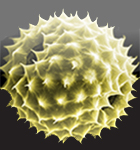Treatment of respiratory allergies
The treatment of respiratory allergies is based on three pillars.

Table of contents:
The most important strategy for a respiratory allergy is to avoid the allergens that trigger it. If the measures taken are insufficient, various medications can help alleviate symptoms. In some cases, allergen-specific immunotherapy (also known as desensitisation) can be considered to treat the cause of the disease. The choice of the right treatment depends, among other things, on the type and severity of the symptoms and should be discussed with an allergist.
Allergen avoidance
Avoiding allergens that trigger allergies is the most effective way to prevent or alleviate symptoms of respiratory allergies. Depending on the trigger, various measures can help sufferers reduce their exposure to allergens.
More information and practical tips on the relevant pages:
Drug treatment
Various medications can be used to treat respiratory allergy symptoms. The most important groups of active ingredients include antihistamines and corticosteroids (cortisone products).
Antihistamines
Histamine is an endogenous messenger substance that plays a key role in allergic reactions. It binds to receptors in certain cells and triggers various reactions in sufferers. Runny nose, sneezing and itchy eyes, for example, are typical respiratory allergy symptoms.
Antihistamines reduce these symptoms by blocking the receptors and thus preventing the effect of histamine. Antihistamines do not take effect until at least half an hour after ingestion.
All antihistamines work in the same way whatever their structure. A distinction is made between first-generation agents (e.g. clemastine, dimetindene, hydroxyzine), second-generation agents (cetirizine, loratadine, azelastine) and third-generation agents such as bilastine, levocetirizine, desloratadine and fexofenadine.
Antihistamines are considered to be effective and safe medications, even for long-term use. In contrast to the first-generation drugs, the new active ingredients do not generally cause drowsiness at the usually prescribed doses.
Good to know: Whether and how an antihistamine works is very individual. It is therefore advisable to test different products in order to find the most suitable active ingredient. Talk to your doctor or seek advice from your pharmacy.
- Oral antihistamines in the form of tablets or drops under the tongue (mainly for children) are used to relieve symptoms in the nose (discharge, itching, sneezing), eyes (burning, tearing) and throat (tingling, itching).
- For mild to moderate symptoms, antihistamines can also be administered in the form of a nasal spray. Products containing azelastine have the advantage that they work faster than other substances, around 15 minutes after application.
- For the treatment of red, irritated and watery eyes, some antihistamines are also available in the form of eye drops.
Corticosteroids
Cortisone is a synthetic active ingredient that fulfils the same functions as the body's own hormone cortisol. Today, there are over twenty different cortisone products with different strengths and effects, which are used specifically and individually depending on the treatment. These substances are also known as glucocorticoids, corticosteroids or steroids. Cortisone products act primarily on the immune system and inhibit inflammatory reactions. Cortisone products in the form of nasal sprays are used locally for moderate to severe allergic rhinitis as well as antihistamines. The most common active ingredients are budesonide, fluticasone, triamcinolone acetonide and mometasone. As it takes about 2 hours for these products to take effect, they must be taken immediately if exposure to the allergen is anticipated, without waiting for symptoms. To achieve a lasting effect, treatment must also be continued once or twice daily for several weeks or months as long as contact with the trigger cannot be avoided and/or symptoms persist.
Good to know: A faster and more effective reaction can be achieved with a nasal spray that combines an antihistamine (e.g. azelastine) and a corticosteroid (e.g. fluticasone). Such products are available on medical prescription.
If nasal sprays containing cortisone are used correctly - even over a longer period of time - they do not usually damage the nasal mucosa. However, the mucous membrane may become dry and irritated; nosebleeds are also possible. If this is perceived as bothersome, an adjustment of the dose can be discussed with the attending physician. Good care in the form of saltwater-based nasal sprays and nasal ointments can also help.
Caution: Decongestant nasal drops and sprays available over the counter in pharmacies or drugstores contain active ingredients that constrict the blood vessels and should be used with caution. Although these substances work quickly, after a few days they can cause side effects such as damage to the cilia of the mucous membrane and are potentially addictive. They are therefore not recommended for the treatment of allergic rhinitis.
In the case of allergic asthma, appropriate treatment must be initiated quickly. This usually consists of inhaled medication containing a form of cortisone and a bronchodilator. It is essential to consult a doctor before use.
Allergen-specific immunotherapy
To date, allergen-specific immunotherapy (also known as desensitisation) is the only causal therapy for respiratory allergies. With successful immunotherapy, symptoms can be reduced or in some cases even completely eliminated. The method consists of slowly acclimatising the body to the triggering allergen so that it no longer overreacts on contact.
Several conditions must be met for allergen-specific immunotherapy to be considered:
- Moderate to severe allergic symptoms are present
- There is a clear allergy diagnosis with precise identification of the trigger
- The symptoms persist despite the measures taken to avoid allergens and treatment with medication.
- There is evidence of the efficacy and safety of allergenspecific immunotherapy for the allergen in question.
- If atopic eczema is present, the symptoms should be brought under control.
- Asthma requires good symptom management.
In some cases, allergen-specific immunotherapy can also be useful for mild symptoms in order to prevent complications such as the development of allergic asthma. However, if allergic asthma is already present, the disease must be well managed before starting therapy.
In the case of respiratory allergies, the effectiveness of immunotherapy for grass, birch and ragweed pollen as well as house dust mites has been proven.
For other triggers of respiratory allergies, such as certain pollens, animal dander and moulds, the available data is insufficient for a general recommendation. In individual cases, however, immunotherapy may be considered, depending on the individual situation of those affected and the extracts available.
More information on allergen-specific immunotherapy
Editors: aha! Swiss Allergy Centre in co-operation with the Scientific Advisory Board.
Final revision of the website content: 26.11.2024




